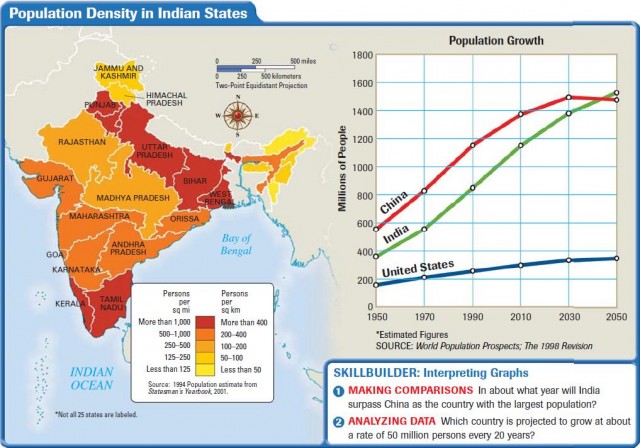South Asia: Population Explosion
A HUMAN PERSPECTIVE On May 11, 2000, at 5:05 A.M., a baby girl was born in a New Delhi hospital. Her parents named her Astha, which means “faith” in the Hindi language. Ordinarily, Astha's birth would not have made news. After all, an estimated 42,000 babies are born in India every day—15,330,000 each year. Astha, however,was special. With this child's birth, the population of India officially hit 1 billion. It was the second country to reach a billion in population; China was the first.
Growing Pains
India's milestone was a mixed blessing. Its population at the beginning of the 21st century is growing so quickly that many of its citizens lack life's basic necessities—food, clothing, and shelter. The question for India, and for South Asia as a whole, is how to manage population growth so that economic development can continue.
POPULATION GROWS
When India gained its independence from Britain in 1947, the population stood at 300 million. By 2000, the population had more than tripled. India's population is so large that even an annual growth rate of less than 2 percent is producing a population explosion. Unless that growth slows down, in 2045, India will be home to more than 1.5 billion people—all living in a land about one-third the size of the United States. India will be the most populous country in the world, surpassing China.
India is not alone in its skyrocketing population. In fact, of the 10 most populous countries in the world in 1998, three were located in South Asia: India, Pakistan, and Bangladesh. South Asia is home to 22 percent of the world's population. But these people live on less than 3 percent of the world's land area.
INADEQUATE RESOURCES
As South Asia's population has increased, regional governments have found it more and more difficult to meet the needs of their people. Widespread poverty and illiteracy, the inability to read or write, have left millions without hope that their lives would improve.
Poor sanitation and the lack of health education have led to outbreaks of disease, which have overwhelmed the region's limited health care systems.

Officials estimate that in order to keep pace with population growth, India will have to do the following every year: build 127,000 new village schools, hire nearly 400,000 new teachers, construct 2.5 million new homes, create 4 million new jobs, and produce an additional 6 million tons of food.
Managing Population Growth
South Asia has struggled for decades to find solutions to its population explosion. But efforts have met with only limited success.
SMALLER FAMILIES
Today, India spends much of its nearly $1 billion annual health-care budget encouraging Indians to have smaller families. “Let's have small families for a stronger India” is one of the slogans of the campaign. For many reasons, however, these programs have had only limited success. Indian women usually marry before age 18 and start having babies early. Also, for the very poor, children are a source of income. They can beg for money in the streets as early as their third birthday and can work the fields not too many years later.
For many Indians, children represent security in old age. The more children a family has, the more likely someone will be around to take care of the parents when they are elderly. Also, the infant mortality rate is very high in South Asia—around 75 per 1,000 live births compared to 7 per 1,000 in the United States. As a result, parents try to have many children to ensure that at least some will reach adulthood.
EDUCATION IS A KEY
Many factors that affect population growth can be changed through education. However, South Asia's governments have a difficult task ahead of them because education funds are limited.
For example, India spends less than $6 per pupil annually on primary and secondary education. (Only a small fraction of this sum is spent on girls.) By contrast, annual per pupil spending on education in the United States is $6,320—more than 1,000 times as much.
Education is essential to break the cycle of poverty and provide South Asians with the means to raise their standard of living. It also helps to improve the status of females by giving them job opportunities outside the home. Better health education also can reduce the need for large families by ensuring that more babies reach adulthood. The future development of South Asia depends on the success of such efforts to control population growth.
In the next section, you will learn how the people of South Asia are coping with another problem—the region's extreme weather.